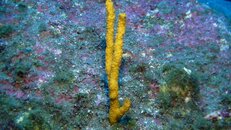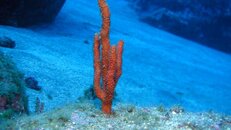Hi all -
I've exhausted all of my local (Hawaii) resources. I have an unusual sponge. For those that don't
dive in Hawaii, most of our sponges are encrusting sponges. This one is more like a rope sponge
like you might find in the Caribbean.
From the sticky at the top of the forum:
(1) How big is the critter?
Specimens vary from 1" to 12" in height
(2) Where in the world is the critter?
Kona, Hawaii
(3) What sort of habitat (reef, wreck, sand, rubble etc) is the critter in?
Rocky substrate
(4) How deep is the critter?
The shallowest specimen I know of is at 170 FSW; I have seen specimens at 250+ FSW.
The attached images were taken at 210 FSW; these specimens are approximately 8" tall.
(5) What time of day (or night) did you see the critter?
Mid day (call it noon)
(6) Any observed behavior of the critter...
It's a sponge - seems to prefer rocky substrate. There are at least two (possibly 3)
color variants (I do not have a photo of the darkest red/purple variety).
(7) If the locals have a common name for the critter, what is it?
None known.
I am happy to collect specimens if someone is interested in helping to ID this unusual (for here)
invertebrate.


I've exhausted all of my local (Hawaii) resources. I have an unusual sponge. For those that don't
dive in Hawaii, most of our sponges are encrusting sponges. This one is more like a rope sponge
like you might find in the Caribbean.
From the sticky at the top of the forum:
(1) How big is the critter?
Specimens vary from 1" to 12" in height
(2) Where in the world is the critter?
Kona, Hawaii
(3) What sort of habitat (reef, wreck, sand, rubble etc) is the critter in?
Rocky substrate
(4) How deep is the critter?
The shallowest specimen I know of is at 170 FSW; I have seen specimens at 250+ FSW.
The attached images were taken at 210 FSW; these specimens are approximately 8" tall.
(5) What time of day (or night) did you see the critter?
Mid day (call it noon)
(6) Any observed behavior of the critter...
It's a sponge - seems to prefer rocky substrate. There are at least two (possibly 3)
color variants (I do not have a photo of the darkest red/purple variety).
(7) If the locals have a common name for the critter, what is it?
None known.
I am happy to collect specimens if someone is interested in helping to ID this unusual (for here)
invertebrate.






